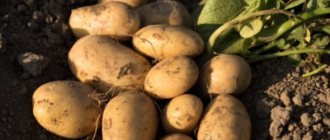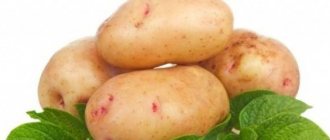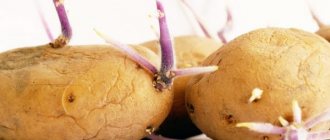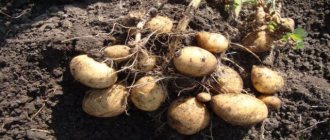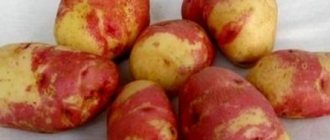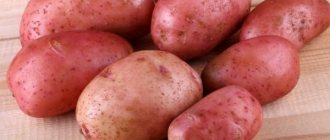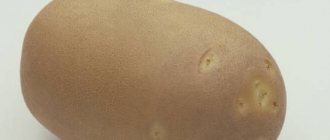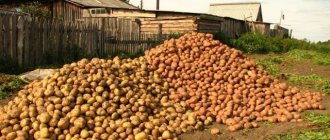The history of the origin of the Kolobok potato variety
The Kolobok variety is the result of selection by Russian specialists from the Institute of Potato Farming named after. Lorja.
The year of inclusion in the State Register of Russia is 2005.
Recommended regions for cultivation: Central and Central Black Earth.
The table shows data on the growing season of different potato varieties:
| Name | Variety | Days |
| Nikulinsky | Late ripening | 115-120 |
| Cardinal | Late ripening | 110-120 |
| Rocco | Late ripening | 100-115 |
| Kiwi | Late ripening | 120-130 |
| Ivan da Marya | Late ripening | 115-130 |
| Slav | Late ripening | From 125 to 140 |
| Borovichok | Early ripening | 70-90 |
| Elmundo | Early ripening | 70-80 |
| Felox | Early ripening | From 65 to 70 |
| Bellarosa | Early ripening | From 50 to 70 |
| Natasha | Early ripening | From 70 to 80 |
| Karatop | Extra early | From 60 to 65 |
| Riviera | Extra early | From 40 to 80 |
| Zhukovsky early | Extra early | 60 to 70 |
| Farmer | Extra early | From 50 to 60 |
| Minerva | Extra early | 45-50 |
| Crane | Mid-late | From 100 to 120 |
| Sorcerer | Mid-late | 80-90 |
| Mozart | Mid-late | From 100 to 180 |
| Ramona | Mid-late | From 80 to 100 |
| Limonka or Picasso | Mid-late | 120-130 |
| Yanka | Mid-early | 90-100 |
| Giant | Mid-early | From 80 to 100 |
| Tuscany | Mid-early | 70-90 |
| Purple Haze | Mid-early | 90-100 |
| Openwork | Mid-early | 75-85 |
Origin
The Kolobok potato variety was created by Russian breeders (Lorch Institute of Potato Farming). Included in the State Register of the Russian Federation in 2005. Zoned for the Central and Central Black Earth regions. The variety is recommended for industrial cultivation. The tubers are used for sale or production of semi-finished potato products.
It can be grown on farms and in private plots. The yield is high, the harvested potatoes are well stored without losing their marketable quality for several months.
Description of the variety
Roots:
- Medium-sized, neat root vegetables;
- Round or oval-round shape;
- The surface is smooth, there are no irregularities or bumps;
- Dense yellow peel, evenly colored;
- Small eyes, medium deep, few, almost invisible;
- Light yellow flesh;
- Average weight varies from 93 to 140 grams;
- Starch content 13-15%;
- The harvest from one bush is 10-15 root crops.
Escapes:
- Medium-sized or tall plant, semi-erect, intermediate type;
- The tops are moderately spreading, the foliage is medium;
- Simple leaves, light green in color, medium to large in size, intermediate in type, with slightly wavy edges and clearly defined veins;
- The large corollas are collected from white or cream-colored flowers;
- The plant has a powerful root system.
Potato bun:
Advantages, disadvantages and taste
The Kolobok variety has the following advantages:
- Pleasant balanced taste;
- Excellent commercial qualities of tubers;
- Good yield;
- Unpretentiousness, versatility of tubers;
- Good keeping quality of the harvested crop;
- Resistant to most diseases.
The variety has no disadvantages.
The only peculiarity is that the “Kolobok” variety is sensitive to fertilizing and watering. The dense peel provides the tubers with protection, but makes them difficult to peel.
Peculiarities
Characteristics:
- Variety "Kolobok" is a mid-season table variety. The growing season is 80 days;
- Productivity reaches from 130 to 220 centners per hectare. Maximum yield - up to 256 centners per hectare;
- The harvested crop does not lose its commercial quality during storage;
- Transportability;
- Seed material collected independently does not degenerate and germinates beautifully.
Early Zhukovsky, Kolobok, Golubizna:
Correct fit
Basic landing rules:
- Planting is carried out in May, in completely heated soil;
- Pre-planting tubers are treated and treated with a growth stimulator;
- The distance between the bushes should be from 30 to 35 cm, the row spacing should be left wide to facilitate further care. Planting material is buried 10 cm.
REFERENCE: For growing, give preference to light sand-based soil.
Care
How to care:
- During the growing season, two or three feedings are carried out, alternating with mineral complexes based on potassium and organic fertilizers (mullein or bird droppings). The abuse of nitrogen-containing fertilizers (urea, ammonium nitrate) is not recommended. The bushes actively gain green mass to the detriment of the development of root crops. Fertilizing should be moderate, since oversaturation with nutrients contributes to the accumulation of nitrates;
- Optimal hydration will be provided by a drip irrigation system. If this is not possible, watering is carried out manually during the dry period. The Kolobok variety will withstand a short-term dry period without consequences, but a constant moisture deficit has a detrimental effect on the harvest. To regulate humidity, they hill up; to control weeds, they mulch.
Digging up potatoes. Variety "Kolobok":
Agricultural technology
Preparation and transfer to the ground
Potatoes of this variety adapt well to a wide variety of soils, but adapt best to light soils. Before planting, you will need to select intact medium-sized tubers.
Before planting, pre-sorted tuber preparations are germinated in the light until shoots about 2-3 cm long appear.
The area on which this type of potato is planted should be prepared in advance: by carefully digging it up and fertilizing it in the fall. With the arrival of spring, it is enough to dig up the beds again and clear them of weeds, then add phosphorus and potassium fertilizers to the loose soil.
How to wear stockings with a dress? What dress to wear with stockings?
To speed up the maturation process, it is enough to follow these simple rules:
- Before planting the prepared material, you must wait until the soil at the planting depth (10-12 cm) warms up to at least +8 degrees.
- In terms of time, these procedures should be tied to the first half of May, when the eyes of the blanks slightly begin to sprout.
- The soil prepared for planting should be moderately moist.
- The planting itself is carried out in rows located along a linear north-south axis, which will provide future plants with acceptable sunlight.
- If groundwater is close, planting should be done in beds slightly elevated above ground level.
- The gap left between the rows should allow you to easily care for the growing bushes (for this it is taken to be at least 60 cm).
- The planting step for potato nests is usually about 30-35 cm.
It is best to plant potatoes in the first half of May.
When planting, add a small handful of ash and about the same amount of compost or humus to each hole. Some potato growers replace them with a mixture of organic fertilizers applied at the rate of about 20 grams per nest.
Features of care and collection
Caring for potatoes of this variety comes down to their hilling, fertilizing and abundant watering, organized during the formation of the ovaries. Loosening the soil should be done three times during the growing season, namely:
- First, when the height of the bushes reaches 25 cm.
- The second time they spud in about 2-3 weeks.
- Another loosening is organized approximately 24 days before harvesting.
At the end of the flowering period, watering potatoes is undesirable, since an abundance of moisture can threaten late blight. During the entire growing season, 2-3 feedings of the nests of the growing plant are also carried out using potassium supplements mixed with droppings or mullein. To avoid drying out of the soil during this period, another hilling with simultaneous mulching is organized.
A sign of the ripening of plant tubers is the complete drying of its stems, which are most often cut off in the form of tops for ease of harvesting. After this, the potatoes are dug up and placed in one row under a canopy to dry.
Drying of the tops is a sign of potato ripening
Diseases and pests
The Kolobok variety is immune against potato cancer, common scab, and various viruses. It is rarely affected by golden cyst nematode or late blight. Necessary preventive measures:
- It is recommended to treat plantings with copper-containing preparations 1-2 times during the peak of the epidemic;
- Maintain crop rotation. During the dormant period, sow the area with phacelia, radish or cabbage;
- Potato tops are “adored” by aphids and Colorado potato beetles. Tubers are often attacked by wireworms, and their vital activity spoils the harvest.
REFERENCE: Tilling the soil before planting helps prevent the appearance of pests. If insects appear, spray the plantings with insecticides.
Features of caring for potatoes after planting
After planting, caring for potatoes will consist of irrigation, weeding, fertilizing and pest control:
Watering. The need for irrigation is directly dependent on the weather. In dry summers, potatoes should be watered three times a week. Watering begins 20 days after the first shoots appear above the ground. If there is a lot of rain, the field does not need to be watered. Moisture is very important for potatoes during tuber formation.
Harrowing. A week after planting, the field is harrowed to limit the growth of weeds. By this time, weed seeds will hatch in the top layer of soil and die immediately after harrowing. This procedure is carried out before sunrise using a light harrow. Before the first potato sprouts appear on the soil surface, harrowing can be done several times, which will significantly reduce the number of weeds.
Weeding. Usually, when removing weeds, loosening is also carried out, the need for which arises after heavy rainfall, when a crust forms on the surface of the dried soil. Loosening between rows should be deep (up to 7 cm), in rows - less deep (up to 3 centimeters) so as not to damage the underground stolons. The first weeding is carried out when the above-ground shoots reach 10–14 cm, the second - before the bushes close in the rows.
Additional feeding. During the growing season, two feedings are carried out. The first is after the sprouts appear. Before the rain, a nutrient mixture of equal proportions of superphosphate and ammonium nitrate (2 tablespoons) is scattered on the field under each bush. The fertilizer will fall into the ground along with the rain. The second feeding is carried out during flowering, fertilizer is poured under the bush. Feeding composition: mix 1 tbsp in 10 liters of water. l. nitrophoska and 2 tbsp. l. superphosphate. Fertilize until the potatoes bloom.
Pest protection. Potatoes must be protected from pests that damage shoots, sprouts, bushes and roots, and later tubers. Particularly dangerous pests: wireworm, Colorado potato beetle, potato cutworm. Insect repellents can be biological or chemical. The biological method is more economical and safer for people and animals and is based on the fact that the crop is adjacent to plants that repel pests. For example, matthiola, marigolds, and wormwood are planted. Potatoes are also sprayed with infusions of garlic and wormwood. For these purposes, you can use biological preparations “Actofit”, “Bitoxibacillin”, “Lepidotsid”, “Bikol”
But insecticides act faster and more effectively; they should be used carefully and only before setting tubers.
Important! Berries formed on potato bushes after flowering are extremely poisonous to humans
Harvesting
As soon as the stems dry, the crop can be harvested. The first harvest is harvested in mid-summer, but potatoes ripen to their maximum by the second half of September. Before harvesting, cut off all potato tops. The harvested crop is sorted and laid out to dry.
We invite you to familiarize yourself with potato varieties that have different ripening periods:
| Late ripening | Early ripening | Very early | Mid-late | Mid-early |
| Nikulinsky | Borovichok | Forty days | Crane | Yanka |
| Cardinal | Elmundo | Karatop | Sorcerer | Giant |
| Rocco | Felox | Riviera | Mozart | Tuscany |
| Kiwi | Bellarosa | Zhukovsky early | Grenada | Purple Haze |
| Ivan da Marya | Natasha | Farmer | Melody | Openwork |
| Picasso | Ariel | Minerva | Margarita | Santana |
| Asterix | Queen Anne | Veneta | Ramona | Desiree |
| Slav | Arosa | Kiranda | Dolphin | Lady Claire |
Growing rules
The description of the potato variety with the original Russian name Kolobok includes some features of its cultivation. They should be taken into account when breeding to obtain a high yield, no matter whether on a small plot or on an industrial scale:
- high yields from Kolobok can only be achieved with qualified and proper care, observing certain nuances;
- a good, strong, stable bush and the maximum number of calibrated tubers can only be obtained with high-quality varietal material;
- Potato Kolobok responds gratefully to fertilizing with plant and chemical fertilizers, but with an excess of nitrogen, it expels the green mass, produces fewer potatoes, and accumulates nitrates in them;
- fertilizing should be done at certain times, and they are always present in the description of the variety;
- preference should be given to organic fertilizers: A.G. Lorch, whose name is given to the All-Russian Scientific Research Institute, which developed original varietal products, believed that chemical fertilizers spoil the taste of any potato;
- a correctly chosen hilling method will not only retain moisture in the soil and prevent the bush from becoming buried, but will also protect the tubers from greening and attack by potato moth caterpillars.
Important: Kolobok will easily tolerate short-term drought, especially if watering was done as needed before flowering, but it is sensitive to a long-term lack of moisture. In the absence of precipitation in hot weather, it is better to water it with drip irrigation or let water flow between the rows.
The variety can be gradually dug up in the middle of summer for trade or food needs, and photos and reviews from gardeners say that at the stage of technical ripeness it retains its excellent taste. But the final collection time comes at the end of the first ten days of September. Excavated at this time, it is suitable for both long-term transportation and long-term storage. If the collected tubers are pre-sorted and dried, its shelf life increases several times.
Tip: The signal for harvesting is the dried tops of the bush. If you collect it after digging and burn it, you will get not only additional organic matter, but also preventive measures to prevent late blight, scab and potato moth.
Reviews about the variety
The Kolobok variety has good taste. Due to the low starch content, the tubers are not subject to overcooking, maintaining a neat shape, and do not darken when cut. Tubers are deep-fried, seasoned in soups, stuffed, baked. Root vegetables of the Kolobok variety are used to produce chips, frozen slices, and vegetable mixtures.
Potatoes from Kolobok and Salut seeds, blue, pink and red potatoes:
Potato variety "Kolobok" is a promising productive variety that is excellent for growing on an industrial scale. It is chosen by farmers who want to get smooth, tasty and beautiful tubers, ideal for sale. The seed material does not degenerate, the tubers are almost not affected by diseases and have excellent immunity.
How to grow this variety
As with other types of potatoes, to get a good harvest you need:
- In the fall, prepare the place for future plantings: weed, dig and fertilize the soil. Any preferred fertilizing options are suitable for this - both organic and mineral.
- In the spring, shallowly plow the area for potatoes and pull out the weeds.
- After plowing, add potash and phosphorus fertilizers.
Dates, scheme and rules of planting
To speed up ripening, it is better to plant potatoes in well-warmed soil. The temperature at the bottom of the potato hole (slightly less than a spade, about 12-17 cm) should rise to +8°C. In most regions of Russia, the soil warms up by mid-May.
For optimal illumination, the rows are arranged along a line from north to south. The distance between the holes is about 30-40 cm, and the gap between the rows is at least 60 cm.
It is important to follow other rules:
- Before planting, germinate the tubers in the light, selecting the most beautiful and strong, medium-sized ones. The sprouts emerging from the eyes should reach 2-3 cm in length by the time of planting. This takes about a month.
- Plant potatoes in moist but not waterlogged soil.
- Make the beds high if the groundwater in the area is close to the surface of the earth.
- It is better to plant the tuber whole, without cutting it. This will make it more resistant to pests and diseases.
- By sparing a handful of humus (compost) and ash for each hole, you will subsequently reap a richer harvest than without such fertilizing at the planting stage.
Care
Timely weeding, hilling and watering during flowering - these are all the basic rules for a good Kolobok harvest.
The first hilling is performed when the bushes grow to 25 cm in height. The next one is in 2-3 weeks. Water the potatoes during flowering. If the summer is dry, then when flowering, it is better to “rain” the potatoes using a watering can or other convenient methods. The water should not be too cold.
When the potatoes fade, stop watering to avoid harm, creating an attractive, moist environment for the development of various diseases.
Kolobok is fed 2-3 times during the summer season. He prefers potassium mineral complexes, mullein or chicken droppings. But nitrogen-containing fertilizers will cause rapid growth of green mass. It is better to alternate organic and mineral fertilizers.
Important! The first feeding is carried out when the sprouts reach 20-30 cm in height. It can be combined with the first hilling. The second - before or during flowering, the third - a few weeks after the second to improve the growth of tubers formed during flowering.
Nuances of cultivation and possible difficulties, diseases and pests
If planting dates, rules for preparing tubers, timely hilling and regular weeding, as well as fertilizing with fertilizers are observed, there are no difficulties with growing this variety.
The most common diseases of the variety:
- Alternaria blight (dry spotting) - looks like small dark spots on the tops; this fungal disease is overcome by drugs such as Albit, HOM, etc.
- Potato nematode . A sign of this pest, hiding underground and invisible to the eye, is “bald spots” in the field, when some of the bushes develop poorly and turn yellow. Nitric acid fertilizers (urea, etc.), as well as compliance with crop rotation, will help to cope with the problem.
- Late blight (brown rot) - the presence of this disease is easily recognized by withering, graying potato shoots and drying of the tops. You can cope with this scourge using an infusion of garlic, a mixture of copper sulfate with boric acid and potassium permanganate, or with the chemicals Fitosporin, Epin, etc.
At the first signs of these diseases, the bushes are treated with preparations containing copper.
Kolobok is also loved by all common pests: the Colorado potato beetle, wireworm, cutworm and others. Plant plants next to the potatoes that will repel insects (marigolds, wormwood, etc.) or treat the bushes with chemicals.
Important! To eliminate the risk of infection of a potato plantation, treat the soil with insecticides or special preparations that improve its composition. An excellent solution is to periodically change the growing location. During dormancy, the ground is planted with green manure plants that improve the composition of the soil - mustard, phacelia, amaranth, calendula, marigolds.
During dry periods, Kolobok is watered, especially if the drought occurs during flowering. The best solution is drip irrigation, but if it is impossible to organize it, regular irrigation will do.

